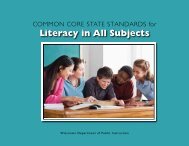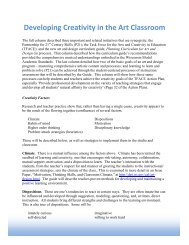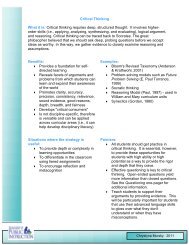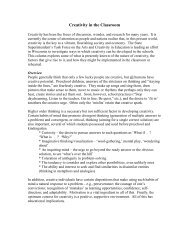Menasha's K-12 Japanese Language and Culture Program
Menasha's K-12 Japanese Language and Culture Program
Menasha's K-12 Japanese Language and Culture Program
- No tags were found...
You also want an ePaper? Increase the reach of your titles
YUMPU automatically turns print PDFs into web optimized ePapers that Google loves.
More than just a<strong>Japanese</strong> class….Menasha’s K-<strong>12</strong> <strong>Japanese</strong><strong>Language</strong> <strong>and</strong> <strong>Culture</strong> <strong>Program</strong>
K-<strong>12</strong> World <strong>Language</strong>Menasha Joint School DistrictMenasha, WI• All students in district have theopportunity to study a World <strong>Language</strong>K-<strong>12</strong>• 3 languages evenly divided betweenelementary schools (German, <strong>Japanese</strong>,Spanish)Grades K-6 requiredGrades 7-<strong>12</strong> elective
K-<strong>12</strong> World <strong>Language</strong>Menasha Joint School DistrictMenasha, WI• K-<strong>12</strong> program started in 1993• K-5 program concentrates on “contentrelated”curriculum• K-10 program---no textbook, uses sets ofclassrooms materials <strong>and</strong> resources• Junior <strong>and</strong> Senior years of HS---can takeclasses for college credit (earning 21-24college credits)K-8 study of WL = 4.9 years of study at HS level (by minutes)3-8 study of WL = 4.1 years of study at HS level (by minutes)
All students in the Menasha JointSchool District will have the chance toexperience <strong>and</strong> learn: anotherlanguage the cultureof thepeople thatspeak thatlanguageBig Question: how do we know they “learned”?
When Menasha Began it’sK-<strong>12</strong> program in 1993,• Added 3 languages tothe elementary schoollevels• Added HS <strong>Japanese</strong>classes• Offered no MS<strong>Japanese</strong> classes• MS <strong>and</strong> HS German<strong>and</strong> Spanish classesalready existed
K-<strong>12</strong> <strong>Japanese</strong> <strong>Program</strong>:4 Levels• Beginning• Transitional• Intermediate• Advanced
CONTENT-RELATED FLES INSTRUCTIONINTEGRATING<strong>and</strong>REINFORCINGAyCarumbaOther areas of the Elementary School Curriculum
What is looks like?Beginning LevelsGrades K-5: Elementary SchoolStudentsstay in thelanguagetheylearned inElementarySchoolGrade 6: Middle School
ArticulationAssessment?’s to ask:How are they related?How does one rely on the other?Bonus: Assessment <strong>and</strong> Articulation are great “PR” tools!
Why we needed to do this…• Promote some “equity” amongst languages• “Square pegs in round holes”• Less “waste” of instruction time to “test”• Not necessary to create “too” manycourses• Students moving “in <strong>and</strong> out”; easierplacement
Example of Spiral CurriculumAlternating Units例Trans.ATrans.BInterm.AInterm.BAdv.AAdvBGrades7-<strong>12</strong>Grades8-<strong>12</strong>Grades9-<strong>12</strong>Grades10-<strong>12</strong>Grades11-<strong>12</strong>Grade<strong>12</strong>Japan <strong>and</strong>theWorld ** *Travel/Transportation** *
Trans Trans Int Int Adv. AdvA B A B A BGrades Grades Grades Grades Grades Grade7-<strong>12</strong>8-<strong>12</strong>9-<strong>12</strong>10-<strong>12</strong>Daily Routines * * *11-<strong>12</strong> <strong>12</strong>School <strong>and</strong> Educ. * * *Shopping * * *Seasonal Events * * *Rites of Passage * * *Japan <strong>and</strong> the World * * *Home <strong>and</strong> Community * * *Leisure/Free Time * * *My Body/My Health * * *Means of Communication * * *Travel/Transportation * * *Self/Family/Friends * * *
In our program:•A student will complete <strong>12</strong> units over thecourse of 2 years within each level•Each unit of study within each level has aset of Benchmarks (PerformanceAssessments) written for each of the 3modes of communication
Each set of Benchmarks (PerformanceAssessments) will score a “point” valuefor each student per unit2pts: Meets or Exceeds an expectation1pt: Does not meet an expectation0pt: No production
A student could score the following:2pts: Meets or Exceeds an expectation1pt: Does not meet an expectation0pt: No production0**At each level, a student could earn up to 24 pointsMiddle SchoolHigh School19/20-24 points Moves to Intermediate A course14/15-19 points Remains in Transitional B course (HSlevel)NOTE: Students’ grades don’t always equal the scores they earn forPerformance Assessments (Benchmarks)
Within each level….• Within a level, learning targets recyclein different contexts (units), 3-4 times• Flexibility in “point” totals allows astudent time to “get it”.
• No “textbook” series used: sets ofclassroom “texts” used as supplementarymaterials in a St<strong>and</strong>ards-Based spiralcurriculum• Each “unit” is based on learning targetsthat spiral in each level• Each level developsdifferent “themes”for each unit
Puzzled?
Scenarios for Students inK-<strong>12</strong>/7-<strong>12</strong>/9-<strong>12</strong><strong>Language</strong> SequenceBeginning Transitional A/B Intermediate A/B Advanced A/BStudent A K-6 Grade 7 <strong>and</strong> 8 Grade 9 <strong>and</strong> 10 Grade 11* <strong>and</strong> <strong>12</strong>*Student B K-6 Grade 7, 8 <strong>and</strong> 9 Grade 10 <strong>and</strong> 11 Grade <strong>12</strong>*Student C Grade 7 <strong>and</strong> 8** Grade 9 <strong>and</strong> 10** Grade 11 <strong>and</strong> <strong>12</strong>** (Grade <strong>12</strong>*)Student D Grade 9 (10**) Grade 10 <strong>and</strong> 11** Grade (11)/<strong>12</strong>*indicates CAPP (college advanced placement for credit) courses**Could advance on Teacher recommendation
Assessment doesn’t mean“Sink or Swim”Assessment“FOR”Learningvs.Assessment“OF”Learning
Advantages for Students• Students can stay in a level more than 2years• Takes away promotion via “seat time”• Students feel less stress in learning• Time to explore multiple “topics” insame level (with same learningtargets)=high level ofstudent interest
Advantages for Staff• Snapshot of overall class “ability” fromday one• Better equipped to assess <strong>and</strong> addressindividual student needs• Better equipped for “combined classes”• Articulation made easy
Advantages for Teachers con’t.• St<strong>and</strong>ards-based Report Cards—done!• P/T conf. question more easilyanswered: “So, what can Kate really dowith her <strong>Japanese</strong>?”
5 Keys to Quality Classroom1. Why AssessAssessmentAssessment processes <strong>and</strong> Results serve clear <strong>and</strong> AppropriatePurposes2. Assess what?Assessments reflect clear <strong>and</strong> valued student learning targets3. Assess how?Learning Targets are translated into assessments that yieldaccurate results4. Communicate how?Assessment results are managed well <strong>and</strong> communicatedeffectively5. Involve Students how?Students are involved in their own Assessment
ChallengesOpportunities• Class names Less competitionbetween languages• Articulation beyond High SchoolPortfolio of Learning Journey• Scheduling More Control for<strong>Japanese</strong> Department七 転 八 起Fall Seven Times, Get up Eight
The Long Range Plan:Get it in Place NowKey Question: What will the“end” look like as you look at thebeginning?
• Develop your transition team(s),“early on” in the process• End of HS: how will it change?(don’t assume the obvious)
• WL teacher professional development,mentors, contacts (district versus schoolprogram)• Plans for “extended” learning (homestays, community events, CLV, tripsabroad, key pals, sister schools)• Plan for your LCTL’s (i.e. recruitingstaff, materials, support)• Survey everyone! A lot! Don’t forgetthe students!“A Rolling Stone Gather No Moss”
Seeing the Big Picture……“The Voyage is not in seeing new l<strong>and</strong>scapes butin seeing with new eyes” –Marcel Proust
Please feel free to contact me:Lynn Sessler Neitzelsesslerl@mjsd.k<strong>12</strong>.wi.us






